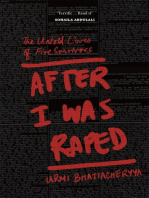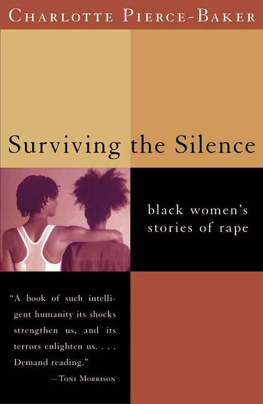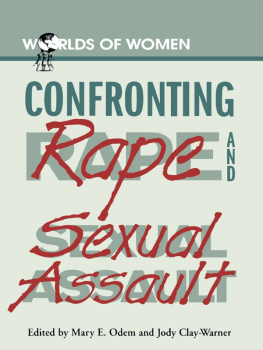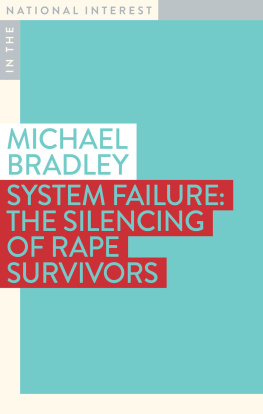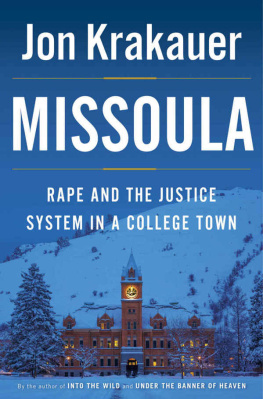

Published in 2015 by The Rosen Publishing Group, Inc.
29 East 21st Street, New York, NY 10010
Copyright 2015 by The Rosen Publishing Group, Inc.
First Edition
All rights reserved. No part of this book may be reproduced in any form without permission in writing from the publisher, except by a reviewer.
Library of Congress Cataloging-in-Publication Data
Henneberg,Susan.
I have been raped. Now what?/Susan Henneberg.First edition.
pages cm.(Teen life 411)
Includes bibliographical references and index.
ISBN 978-1-4994-6142-8 (library bound)
1. RapeJuvenile literature. 2. Rape victimsJuvenile literature. 3. Rape victimsServices forJuvenile literature. I. Title.
HV6558.H435 2016
362.88308352dc23
2014040076
Manufactured in the United States of America
For many of the images in this book, the people photographed are models. The depictions do not imply actual situations or events.
INTRODUTION
I t was an unimaginable act of violence. On August 11, 2012, two Steubenville, Ohio, high school football players raped a sixteen-year-old girl from West Virginia. For over six hours, they repeatedly assaulted the girl, who had passed out from drinking alcohol. Then they, and other witnesses, posted photos and videos of the assault on social media and in text messages to friends.
The crime tore apart the town. Two of the boys charged with the rape were convicted. One was sentenced to one year in juvenile detention. The other was sentenced to two years in detention. Several of the adults who protected the offenders were brought up on criminal charges. Classmates threatened the victim on Twitter. Some media commentators sympathized with the offenders. The tragic ordeal didnt end there for the victim. Her name was released on national television.
The statistics on teen rape are sobering. According to a 2010 survey conducted by the Centers for

People protested against Steubenvilles law enforcement agencies. They claimed that they attempted to cover up the rape.
Disease Control and Prevention (CDC), nearly one in five women and one in seventy-one men have been raped in their lifetimes. Almost half of them experienced their first rape before age eighteen. Teens who identify as lesbian, gay, and bisexual experience equal or higher rates of sexual violence. Only three out of every one hundred rapists will ever go to jail, according to an analysis of Justice Department data done by the Rape, Abuse & Incest National Network (RAINN).
Survivors of rape and sexual assault say victims often never recover from the nightmare. They feel shame and guilt. They experience physical, psychological, and social consequences. They may suffer from post-traumatic stress disorder (PTSD). They get depressed, develop sleep disorders, and find it difficult to resume normal life. They sometimes engage in behaviors such as using drugs, cutting, or overeating. In two recent well-publicized cases, the victims committed suicide.
You, or someone you know, may be a victim of rape or sexual assault. You may be male or female, live in wealth or in poverty. You may be an A student or a dropout. You may have told the police or a trusted adult, or you may still be suffering in silence. Whatever your circumstances, those who have survived rape, and those who have helped the survivors, have two very important messages for you. The first one is that no matter how much you had to drink, what you wore, or what you did before the assault, it is not your fault. If you are under the age of consent or you did not give clear consent to have sex, it is rape.
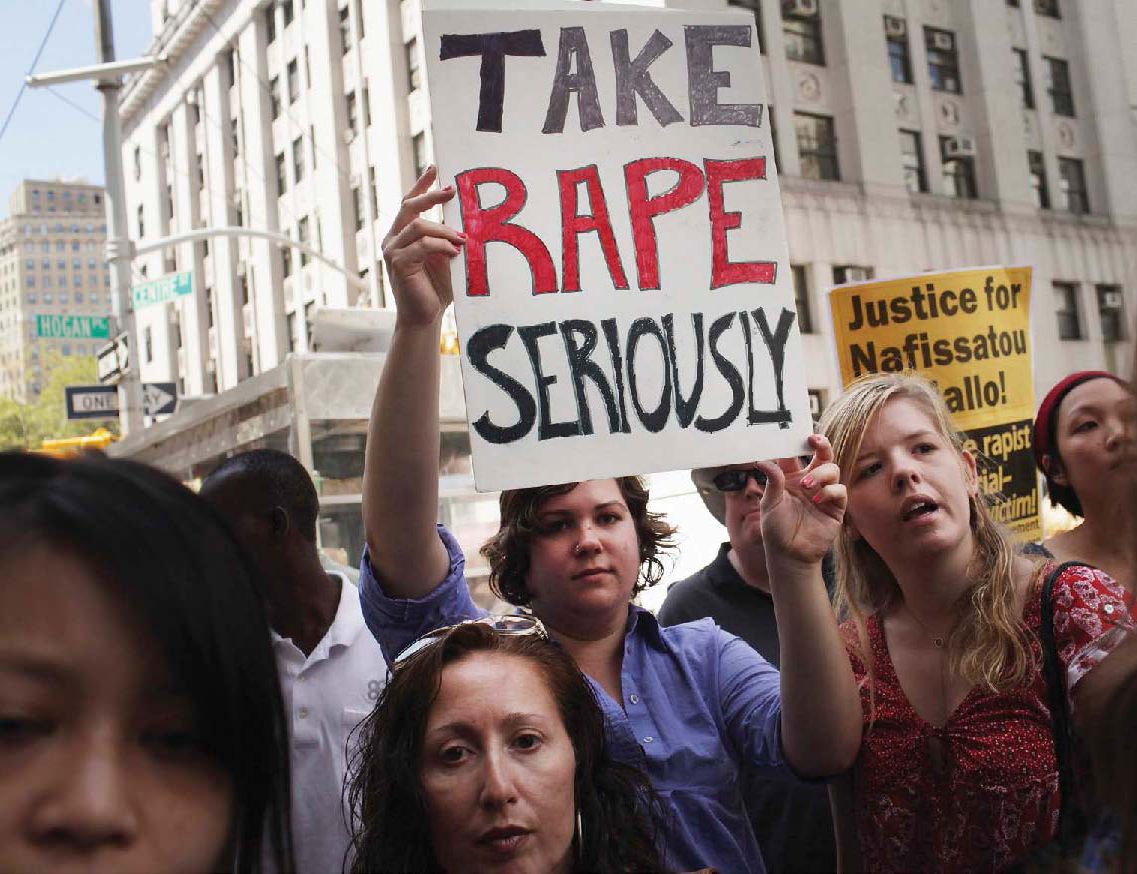
New York residents were outraged when a judge dismissed charges that a prominent French economist sexually assaulted a hotel maid in 2011.
The second message from rape survivors is that you do not have to endure this trauma alone. If you are courageous enough to tell someone, there is a whole community ready to help you find your way back to wholeness. You may choose to stay silent and try to recover on your own. However, most rape victims say that the support they received from family, friends, law enforcement, rape counselors, and the criminal justice system made all the difference in being able to move on with their lives. Learning as much as you can about the causes and effects of rape may help you and your community prevent future rapes. Rapists can be brought to justice. Victims can eventually heal.
CHAPTER
THE FACTS ABOUT RAPE
E very two minutes, someone in the United States is raped, reports RAINN. Almost half of the victims are eighteen or younger. One in ten rape victims is male. Ninety-three percent of teen victims know their attacker. Teens are raped by family members, coaches, school friends and acquaintances, and their boyfriends.
Rape is a traumatic experience no matter what the age of the victim. For teens, it can be devastating. They are overwhelmed by emotions. They may be physically injured. They have to make adult decisions such as whom to tell, whether to go to the hospital, or whether to call the police. After the rape, they may still have to see their attackers every day.
Maybe you know someone who was raped. She may have told you but didnt tell her mother. According to a 2007 Utah survey, 70 percent of teens told a friend about their rape, compared to 12 percent who told a parent. She probably didnt report it. Only 40 percent of victims notify the police about the assault, according to RAINN. Male victims report less frequently than females. Your friend might have been intoxicated. The National Institute on Alcohol and Alcoholism estimates that half of all teen perpetrators and half of all teen sexual assault victims had been drinking to excess.
You may notice that the rape victims behavior changed after the rape. He may act withdrawn and quiet. She may act depressed, skip school, and withdraw from friends. Victims may be harassed on Facebook or Twitter, especially if there are cell phone photos. Victims physical wounds may heal, but they dont get over it They often cant seem to put the event behind them.
This was the case for fifteen-year-old Audrie Pott, a sophomore at Saratoga High School in Northern California. In the beginning of the 2012 school year, she had gone to a party at a friends house whose parents were away. She drank alcohol mixed with Gatorade. According to a 2013 Rolling Stone article, everyone at the party, including Audrie, was trashed. Several boystook her upstairs to a bedroom and removed her clothes. They wrote all over her with Sharpies and then took cell phone photos. They then raped her with their fingers.

Audrie Potts parents worked to pass a cyberbullying law after photos of their daughters rape were posted on social media.
When Audrie woke up the next morning, she called her mom to pick her up. Before long, the story was all over her school. She put on a brave face, but friends noticed by the marks on her arms that she had begun cutting. Only two weeks after the party, Audrie couldnt take the humiliation anymore. She hanged herself in her bathroom. In 2013, two boys at her school were convicted of raping her at the party and texting cell phone photos of the assault to their friends.
Next page






